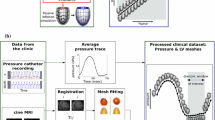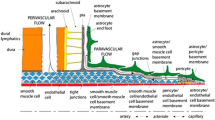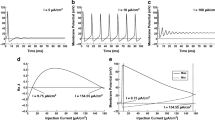Abstract
This work develops a mathematical model for the atrioventricular (AV) node in the human heart, based on recordings of electrical activity in the atria (the upper chambers of the heart) and the ventricles (the lower chambers of the heart). Intracardiac recordings of the atrial and ventricular activities were recorded from one patient with atrial flutter and one with atrial fibrillation. During these arrhythmias, not all beats in the atria are conducted to the ventricles. Some are blocked (concealed). However, the blocked beats can affect the properties of the AV node. The activation times of the atrial events were regarded as inputs to a mathematical model of conduction in the AV node, including a representation of AV nodal concealment. The model output was compared to the recorded ventricular response to search for and identify the best possible parameter combinations of the model. Good agreement between the distribution of interbeat intervals in the model and data for durations of 5 min was achieved. A model of AV nodal behavior during atrial flutter and atrial fibrillation could potentially help to understand the relative roles of atrial input activity and intrinsic AV nodal properties in determining the ventricular response.
Similar content being viewed by others
References
Amellal, F., K. Hall, L. Glass and J. Billette (1996). Alternation of atrioventricular nodal conduction time during atrioventricular reentrant tachycardia: are dual pathways necessary? J. Cardiovasc. Electrophysiol. 7, 943–951.
Billette, J. and S. Nattel (1994). Dynamic behavior of the atrioventricular node: a functional model of interaction between recovery, facilitation, and fatigue. J. Cardiovasc. Electrophysiol. 5, 90–102.
Bootsma, B. K., A. T. Hoelen, J. Strackee and F. L. Meijler (1970). Analysis of R-R intervals in patients with atrial fibrillation at rest and during exercise. Circulation 41, 783–794.
Chorro, F. J., C. J. H. J. Kirchof, J. Brugada et al. (1990). Ventricular response during irregular atrial pacing and atrial fibrillation. Am. J. Physiol. 259, H1015–H1021.
Cohen, R. J., R. D. Berger and T. E. Dushane (1983). A quantitative model for the ventricular response during atrial fibrillation. IEEE Trans. Biomed. Eng. 30, 769–781.
Damato, A. N., O. J. Varghese, S. H. Lau, J. J. Gallagher and G. A. Bobb (1972). Manifest and concealed reentry. A mechanism of AV nodal Wenckebach phenomenon. Circ. Res. 30, 283–292.
Decherd, G. M. and A. Ruskin (1946). The mechanism of the Wenckebach type of A-V block. Br. Heart J. 8, 6–16.
Goldstein, R. E. and G. O. Barnett (1967). A statistical study of the ventricular irregularity of atrial fibrillation. Comput. Biomed. Res. 1, 146.
Hashida, E., N. Yoshitani and T. Tasaki (1978). A study on the irregularity of the sequence of R-R intervals in chronic atrial fibrillation in man based on the time series analysis and the information theory. Jpn. Heart J. 19, 839–851.
Heethaar, R. M., J. J. D. van Der Gon and F. L. Meijler (1973a). Mathematical model of AV conduction in the rat heart. Cardiovasc. Res. 7, 105–114.
Heethaar, R. M., R. M. De Vos Burchart, J. J. D. van Der Gon and F. L. Meijler (1973b). A mathematical model of AV conduction in the rat heart. II. Quantification of concealed conduction. Cardiovasc. Res. 7, 542–556.
Lammers, W. J. E. P., F. Ravelli, M. Disertori, R. Antolini, F. Furlanello and M. A. Allessie (1991). Variations in human atrial flutter cycle length induced by ventricular beats: evidence of a reentrant circuit with a partially excitable gap. J. Cardiovasc. Electrophysiol. 2, 375–387.
Langendorf, R. (1948). Concealed A-V conduction: the effect of blocked impulses on the formation and conduction of subsequent impulses. Am. Heart J. 35, 542–552.
Lewis, T. and A. M. Master (1925). Observations upon conduction in the mammalian heart. A-V conduction. Heart 12, 209–269.
Meijler, F. L., J. Jalife, J. Beaumont and D. Vaidya (1996). AV nodal function during atrial fibrillation: the role of electrotonic modulation of propagation. J. Cardiovasc. Electrophysiol. 7, 843–861.
Meijler, F. L., J. Stackee, F. J. L. van Capelle and J. du Perron (1968). Computer analysis of the RR interval-contractility relationship during random stimulation of the isolated heart. Circ. Res. 22, 695–702.
Moe, G. K. and J. A. Abildskov (1964). Observations on the ventricular dysrhythmia associated with atrial fibrillation in the dog heart. Circ. Res. 14, 447–460.
Pavri, B. B., D. Kocovic and M. Hanna (1999). Long-short RR intervals and the right bundle branch. J. Cardiovasc. Electrophysiol. 10, 121–123.
Pick, A. and R. Langendorf (1979). Interpretation of Complex Arrhythmias, Philadelphia: Lea & Febiger.
Press, W. H., S. T. Teukolsky, W. T. Vetterling and B. P. Flannery (1993). Numerical Recipes in C: The Art of Scientific Computing, Cambridge: Cambridge University Press. Also see: http://www.ulib.org/webRoot/Books/Numerical-Recipes/bookcpdf.html.
Ravelli, F., M. Disertori, F. Gozzi, R. Antolini and M. A. Allessie (1994). Characterization of atrial flutter. Studies in man after open heart surgery using fixed atrial electrodes. Circulation 89, 2107–2116.
Shrier, A., H. Dubarsky, M. Rosengarten, M. R. Guevara, S. Nattel and L. Glass (1987). Prediction of complex atrioventricular conduction rhythms in humans with use of the recovery curve. Circulation 76, 1196–1205.
Stackee, J., A. J. Hoelen, N. E. Zimmerman and F. L. Meijler (1971). Artificial atrial fibrillation in the dog. An artifact? Circ. Res. 28, 441–445.
Stambler, B. S. and K. A. Ellenbogen (1996). Elucidating the mechanisms of atrial flutter cycle length variability using power spectral analysis techniques. Circulation 94, 2515–2525.
Sun, J., F. Amellal, L. Glass and J. Billette (1995). Alternans and period-doubling bifurcations in atrioventricular nodal conduction. J. Theor. Biol. 173, 79–91.
Talajic M., D. Papadatos, C. Villemaire, L. Glass and S. Nattel (1991). A unified model of atrioventricular nodal conduction predicts dynamic changes inWenckebach periodicity. Circ. Res. 68, 1280–1293.
Task Force of the European Society of Cardiology and the North American Society of Pacing and Electrophysiology: heart rate variability (1993). Standards of measurement, physiological interpretation, and clinical use. Circulation 93, 1043–1065.
van Capelle, F. J. L., J. C. du Perron and D. Durrer (1971). Atrioventricular conduction in isolated rat heart. Am. J. Physiol. 221, 284–290.
Waxman, M. B., L. Yao, D. A. Cameron and J. A. Kirsh (1991). Effects of posture, valsalva maneuver and respiration on atrial flutter rate: an effect mediated through cardiac volume. J. Am. Coll. Cardiol. 17, 1545–1552.
Wells, J. L., W. A. H. MacLean, T. N. James and A. L. Waldo (1979). Characterization of atrial flutter. Studies in man after open heart surgery using fixed atrial electrodes. Circulation 60, 665–673.
Zeng, W. and L. Glass (1996). Statistical properties of heartbeat intervals during atrial fibrillation. Phys. Rev. E 54, 1779–1784.
Author information
Authors and Affiliations
Corresponding author
Rights and permissions
About this article
Cite this article
Jørgensen, P., Schäfer, C., Guerra, P.G. et al. A mathematical model of human atrioventricular nodal function incorporating concealed conduction. Bull. Math. Biol. 64, 1083–1099 (2002). https://doi.org/10.1006/bulm.2002.0313
Received:
Accepted:
Issue Date:
DOI: https://doi.org/10.1006/bulm.2002.0313




